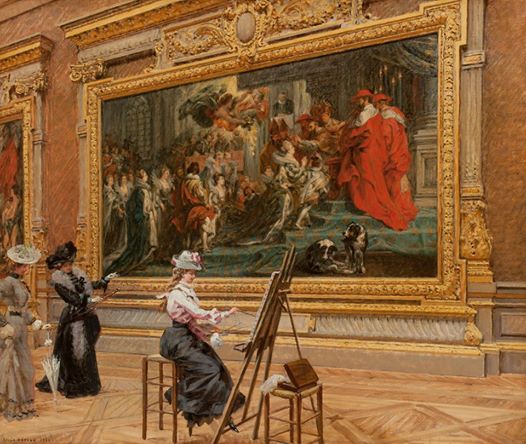Louis Béroud (French, 1852–1930)
The Earnest Pupil in the Rubens Room, Louvre, Paris, 1902
Oil on Canvas, 21 1/4 x 25 1/2 in.
Signed lower left: Louis Béroud 1902
2000.3

A painter best known for his contemporary museum and theater scenes, Béroud’s oeuvre reflects the spirit of Belle Époque Paris. Although Béroud received formal training from decorators Jean-Baptiste Lavastre and Pierre Eugène Gourdet as well as the prominent academic painter Léon Bonnat, his lifelong interest in museums—in particular, the Musée du Louvre— most clearly influenced his later work. Béroud avidly copied from the Louvre’s collection and was particularly fond of the Old Masters. His interest in studying exemplary works of the Italian Renaissance and Northern Baroque led him to uncover the theft of the Mona Lisa in 1911. Béroud arrived at the Louvre on the morning of August 22, 1911, to continue work on his painting Mona Lisa at the Louvre (location unknown), only to discover that the famed painting was not hanging in its usual place. Annoyed by the painting’s absence, and assuming that it had been moved by the staff, Béroud inquired when the painting would be returned, thus unknowingly sounding the alarm of the Mona Lisa’s disappearance (it would take two years for the Louvre to recover the stolen work of art).
The Earnest Pupil in the Rubens Room, Louvre, Paris is an excellent example of depicting the experiences of artists and museum visitors at the Louvre that delighted Béroud. He debuted the Salon in 1873 with The Apollo Gallery, Louvre, Paris (location unknown), later winning a third-class medal for his Au Salon Carré du Louvre (Musée Fabre, Montpellier) at the Salon of 1883 as well as a bronze medal at the Exposition Universelle in 1900. In The Earnest Pupil in the Rubens Room, Louvre, Paris, a female artist paints before The Coronation in St. Denis from Peter Paul Rubens’s Marie de Medici cycle (1622–1624). Somewhat more practically dressed than the two female museum visitors admiring the painting behind her, Béroud’s pupil wears a sober black skirt and light pink shirtwaist, teetering on her stool as she reaches to apply paint to canvas. Rubens’s work presents Marie de Medici being crowned Queen of France and, according to the American writer Mary Knight Potter in 1904, was “universally regarded as being not only the best of the series, but one of the really fine compositions of Rubens’s life.” That Béroud depicts this female artist—the earnest pupil—sitting before such a great work of art, learning from it, may reflect politics around women’s art education at the turn of the century. Opinions about the impropriety of women studying from nude models were hotly contested in debates that led to women’s admittance to the École des Beaux-Arts in 1897. In lieu of drawing live models, copying Old Masters was seen as a viable alternative for female artists.


